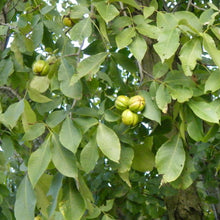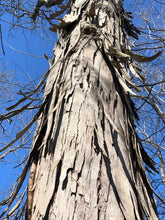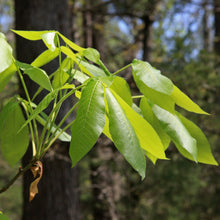|
Mature height x width: |
approx 60-80' x 40' |
|
Recommended initial spacing: |
5'-10' in rows 20' apart (to be thinned later) |
|
Recommended final spacing: |
20-30' (intermediate) 50' (final) |
| Hardy to: | approx -25°C |
|
Preferred soil: |
deep, moist, fertile soils. |
|
Good for: |
long storage, ornamental, slow-growing |
|
Uses: |
dessert, main dish |
Shagbark hickories are not well-known as nut-bearing trees, but they produce a tasty, buttery nut. They are particularly ornamental because of their remarkable peeling, 'shaggy' bark. Additionally, they have incredible fall colours and valuable wood. Adapted as they are to deep forests, hickories grow slowly initially but eventually become massive trees (up to 80 feet tall!)
Genetics: Shagbark hickories are native to the eastern US and Southern Ontario, and these seedlings are from the Niagara region, in the northern part of their range, selecting from the most productive trees with the best kernel extraction capacity. We recommend at least two trees (ideally more) to ensure the best crop.
Planting: hickories want deep, fertile soil with pH 5 to 8. They can tolerate shade, but expect slow growth and limited yields in the shade.
Why seedlings? Growing seedlings from productive, vigorous parents helps maintain diversity (each seed is a new variety) while drawing on some of the best genetics available. In other words, by planting seedlings, you are participating in the breeding and selection of new, regionally-adapted varieties!
Why potted? If you won't be planting your trees right away and you don't feel sure about storing bare root trees then you want potted trees. Potted trees will allow you more flexibility with transplanting timelines and late spring installations, however, they are more expensive to produce and to ship.
Our nuts are grown in tree pots, which are designed with a large opening at the bottom to air prune the root. When the taproot reaches the bottom, instead of circling around, the opening enables the root to gently 'self-prune' itself, stimulating the growth of feeder roots further up.







